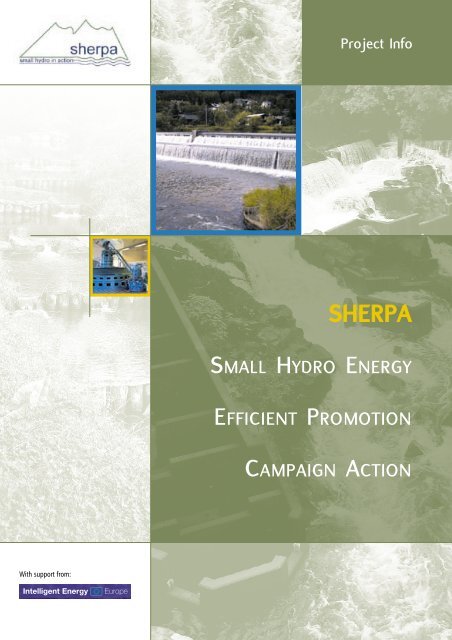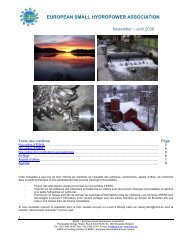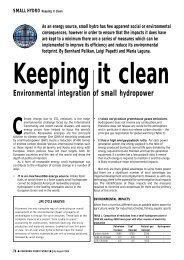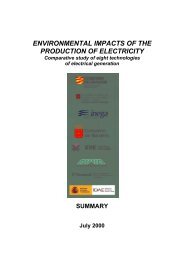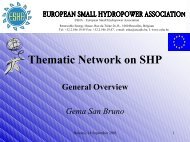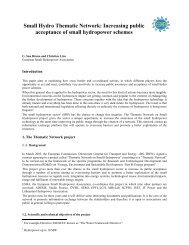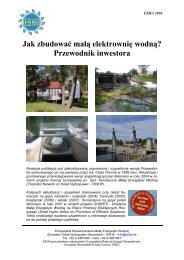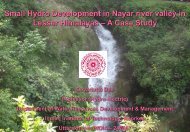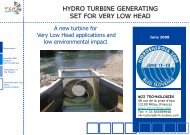Download SHERPA presentation Leaflet - ESHA
Download SHERPA presentation Leaflet - ESHA
Download SHERPA presentation Leaflet - ESHA
Create successful ePaper yourself
Turn your PDF publications into a flip-book with our unique Google optimized e-Paper software.
With support from:<br />
Project Info<br />
<strong>SHERPA</strong><br />
SmAll HydRo EnERgy<br />
EfficiEnt PRomotion<br />
cAmPAign Action
In the framework of the European Directive on the promotion<br />
of Electricity from Renewable Energy Sources (RES-e) and<br />
the Kyoto Protocol, the European Union has to develop<br />
Renewable Energy Sources (RES): indeed, European targets<br />
have been set for renewables - a share of 12% of renewable<br />
energy in gross inland energy consumption, and a share of<br />
22% for green electricity, by 2010 - and the policy framework<br />
has been shaped, following the objectives of environmental<br />
protection, ensuring sustainable security of energy supply by<br />
reducing dependence on energy imports and the improvement<br />
of industrial competitiveness and having a positive impact on<br />
regional development and employment. For of all these reasons<br />
the promotion of electricity from renewable energy sources is<br />
a high Community priority. The European policy framework<br />
for renewable energy gives Member States a reason to look<br />
at Small Hydropower (SHP), because it has the best trackrecord<br />
of all renewable energy technologies, being a clean<br />
and very efficient renewable energy source. However, recent<br />
growth rates have been disappointing, because:<br />
Numerous institutional<br />
barriers for further SHP<br />
developments still exist.<br />
Impression that the<br />
technology is already mature and fully developed,<br />
despite the existing remaining potential.<br />
Impression that hydro plants must<br />
adversely affect river ecosystems, when a<br />
well-designed SHP plant should blend in<br />
with its surroundings and have minimal<br />
negative environmental impacts.<br />
The inconsistency in the implementation<br />
of two European Directives (Water Framework<br />
Directive - WFD vs. Renewables Electricity<br />
Directive RES-e).<br />
There is a lack of spatial planning approaches,<br />
where the development of SHP is included in<br />
local plans, putting great emphasis on<br />
environmental integration.<br />
Small Hydro Energy Efficient Campaign Action, is a European Funded Project in the Framework of<br />
<strong>SHERPA</strong> the Intelligent Energy for Europe Programme (IEE). <strong>SHERPA</strong> aims to make a significant contribution<br />
in reducing the barriers that are currently hindering the development of SHP, addressing the challenges and contributing to the<br />
uptake of SHP in the new enlarged European Union. The results of <strong>SHERPA</strong> will not only increase the awareness of politicians<br />
and decision makers on SHP as a key renewable energy source, but will also create favourable framework conditions for the<br />
further uptake of SHP within the European Union. The project specifically addresses the issue of environmental performance of<br />
SHP plants, as well as a comprehensive territorial planning approach at the level of water bodies. <strong>ESHA</strong>, the European Small<br />
Hydropower Association, is the European co-ordinator of this project, which includes eight additional partners:<br />
Slovenian Small Hydropower Association, SSHA, Slovenia<br />
Lithuanian Hydropower Association, LHA, Lithuania<br />
Italian Renewable Energy Producers Association, APER, Italy<br />
Swedish Renewable Energy Association, SERO, Sweden<br />
Innovation Energy and Development, IED, France<br />
Institute of Water Management, Hydrology and Hydraulic<br />
Engineering from University of Natural Resources, IWHW, Austria<br />
EC Baltic Renewable Energy Centre EC BREC/CLN, Poland<br />
French Energy and Environment Agency, ADEME, France<br />
<strong>SHERPA</strong> will run for 24 months starting from October 2006.
What are the key topics of sherpa?<br />
Strengthen market development of SHP in New Member States: in order to facilitate this process, it is proposed<br />
to promote policy dialogue and information dissemination on SHP, that will foster the market penetration of SHP.<br />
Strengthen implementation and consistency of EU directives: (RES-e directive and SHP targets of<br />
White Paper, WFD); To ensure the effectiveness and complementarity of future policy instruments,<br />
policy fora will be organised as platforms to address issues such as WFD vs RES-e, targets,<br />
licensing process, support schemes, territorial planning approaches etc.<br />
Improving SHP public image: public image campaigning, addressing specifically the issue of environmental<br />
integration: through best practice examples on environmental integration, public image folders,<br />
and workshops for dialogue with NGOs and environmentalists.<br />
Strengthen the implementation of local territorial approaches: to overcome major environmental constraints<br />
to further SHP development and through the implementation of comprehensive analysis at the level of<br />
the water bodies, with strong participatory approach and clear involvement of local authorities.<br />
Who are the key actors and the main target group?<br />
Politicians at EU, national, regional as well as local level<br />
Experts and decision makers<br />
European SHP industry<br />
NGOs, environmentalists<br />
Which documentation is<br />
sherpa going to deliver?<br />
<strong>SHERPA</strong> aims at developing and implementing a concise, welltargeted<br />
and thematic approach to ensure the dissemination and<br />
market uptake of SHP in Europe, through publications, workshops,<br />
policy fora etc. The main deliverables are:<br />
Report on Status of SHP Policy Frameworks<br />
& Market Development in EU-25<br />
Public image folders for SHP<br />
Report on technical and operational procedures to<br />
better integrate Small hydro plants in the environment<br />
Report on mechanisms of social engineering<br />
Report on ISO 14001 and SHP<br />
Assessment of power productivity with<br />
reference to objectives and targets<br />
set by WFD and RES-e directives<br />
Economic analysis of environmental mitigation<br />
activities and equipment for SHP<br />
SHP local plans in France and Italy<br />
Good practice brochure of participatory<br />
approach for SHP development<br />
<strong>SHERPA</strong> Policy session in Hidroenergia<br />
2008, Bled, Slovenia<br />
SHP National Policy Fora in Lithuania,<br />
France, Italy, Poland and Sweden<br />
KEY TOPICS
How to ParticiPate in SHerPa activitieS?<br />
<strong>SHERPA</strong> activities are open to different stakeholders (SHP<br />
industry, environmentalists, Politicians, NGOS) willing to<br />
participate. Environmental stakeholders are welcome to be<br />
involved in developing the different activities of the project,<br />
essentially for reviewing and drafting project results, and<br />
participating in workshops and policy fora.<br />
Contacts details of <strong>ESHA</strong><br />
If you want to know more about <strong>SHERPA</strong>, please visit<br />
<strong>SHERPA</strong> website at www.esha.be/sherpa or send an<br />
email to Maria Laguna at maria.laguna@esha.be<br />
EUROPEAN SMALL HYDROPOWER ASSOCIATION<br />
63-65, Rue d’Arlon • B-1040 Brussels • Belgium<br />
T: +32 2 546 1945 • F: +32 2 546 1947<br />
E: info@esha.be • I: www.esha.be<br />
<strong>ESHA</strong> is founding member of EREC, the European Renewable Energy Council<br />
Printed on Ecological friendly paper (Chlorine-free paper) Design: ACG Brussels. Photo Credits: <strong>ESHA</strong>, KÖ, SERO, IED, BOKU, GPAE


